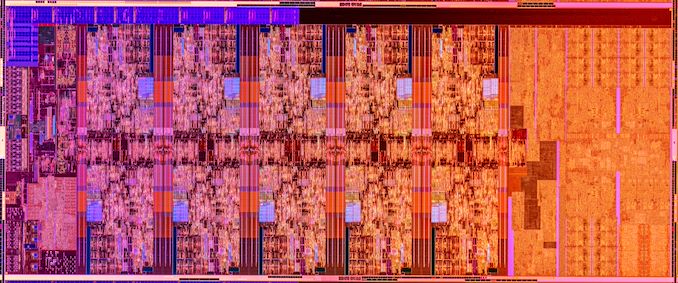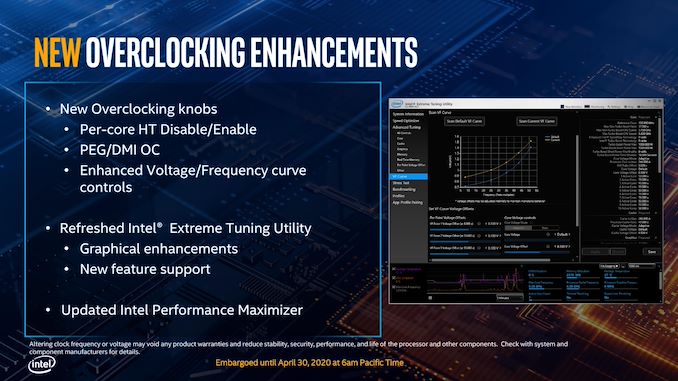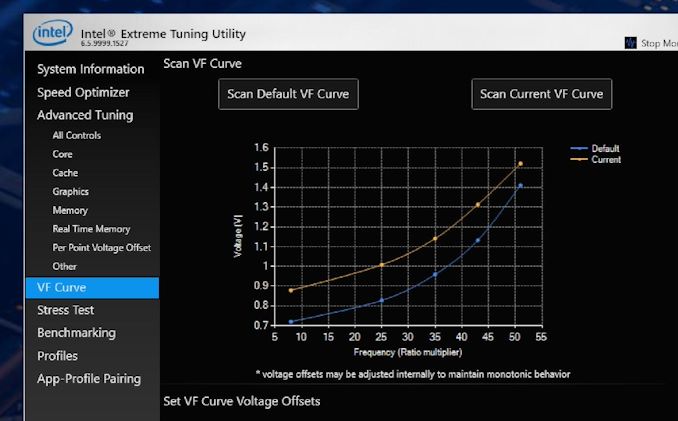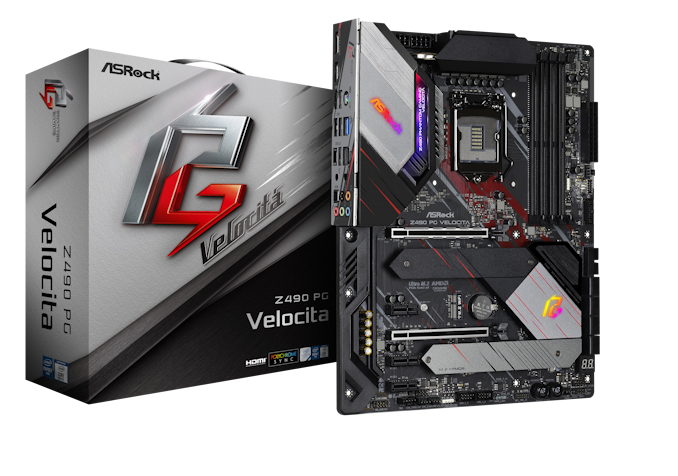Intel’s 10th Gen Comet Lake for Desktops: Skylake-S Hits 10 Cores and 5.3 GHz
by Dr. Ian Cutress on April 30, 2020 9:00 AM EST- Posted in
- CPUs
- Intel
- Overclocking
- 14++
- Z490
- Comet Lake
- B460
- H470
Socket, Silicon and Security
The new CPUs have the LGA1200 socket, which means that current 300-series motherboards are not sufficient, and users will require new LGA1200 motherboards. This is despite the socket being the same size. Also as part of the launch, Intel provided us with a die shot:
It looks very much like an elongated Comet Lake chip, which it is. Intel have added two cores and extended the communication ring between the cores. This should have a negligible effect on core-to-core latency which will likely not be noticed by end-users. The die size for this chip should be in the region of ~200 mm2, based on previous extensions of the standard quad core die:
- CFL 4C die: 126.0 mm2
- CFL 6C die: 149.6 mm2
- CFL 8C die: 174.0 mm2
- CML 10C die: ~198.4 mm2

Original 7700K/8700K die shots from Videocardz
The only silicon we know to be guaranteed inside each retail box is that the ten core parts have to have the 10C silicon. Beyond that, Intel could make any of the eight core Core i7 parts use either a native 8C silicon, or 10C silicon with two disabled cores. Similarly, the six core Core i5 could either be native 6C silicon, harvested 8C silicon, or harvested 10C silicon. We have reached out to Intel for clarification, given that in previous generations Intel sometimes offered different TDP values for the harvested dies. There's even a possibility that Intel could be reusing the same Coffee Lake silicon masks and just binning them to Comet Lake specifications.
For security, Intel is applying the same modifications it had made to Coffee Lake, matching up with the Cascade Lake and Whiskey Lake designs.
| Spectre and Meltdown on Intel | ||||||
| AnandTech | Comet Lake |
Coffee Refresh |
Cascade Lake | Whiskey Lake |
||
| Spectre | Variant 1 | Bounds Check Bypass | OS/VMM | OS/VMM | OS/VMM | OS/VMM |
| Spectre | Variant 2 | Branch Target Injection | Firmware + OS | Firmware + OS | Hardware + OS | Firmware + OS |
| Meltdown | Variant 3 | Rogue Data Cache Load | Hardware | Hardware | Hardware | Hardware |
| Meltdown | Variant 3a | Rogue System Register Read | MCU* | Firmware | Firmware | Firmware |
| Variant 4 | Speculative Store Bypass | Hardware + OS | Firmware + OS | Firmware + OS | Firmware + OS | |
| Variant 5 | L1 Terminal Fault | Hardware | Hardware | Hardware | Hardware | |
The fix for V3a has now changed from ‘Firmware’ to ‘MCU’, suggesting that Intel has added a microcontroller as a fix. We have asked Intel for clarification. Intel is now claiming that V4 is fixed through a combination of hardware and OS fixes.
Die Thinning
One of the new features that Intel is promoting with the new Comet Lake processors is die thinning – taking layers off of the silicon and in response making the integrated heat spreader thicker in order to enable better thermal transfer between silicon and the cooling. Because modern processors are ‘flip-chips’, the bonding pads are made at the top of the processor during manufacturing, then the chip is flipped onto the substrate. This means that the smallest transistor features are nearest the cooling, however depending on the thickness of the wafer means that there is potential, with polishing to slowly remove silicon from this ‘rear-end’ of the chip.
In this slide, Intel suggests that they apply die thinning to products using STIM, or a soldered thermal interface. During our briefing, Intel didn’t mention if all the new processors use STIM, or just the overclockable ones, and neither did Intel state if die thinning was used on non-STIM products. We did ask how much the die is thinned by, however the presenter misunderstood the question as one of volume (?). We’re waiting on a clearer answer.
Overclocking Tools and Overclocking Warranties
For this generation, Intel is set to offer several new overclocking features.
First up is allowing users to enable/disable hyperthreading on a per-core basis, rather than a whole processor binary selection. As a result, users with 10 cores could disable HT on half the cores, for whatever reason. This is an interesting exercise mostly aimed at extreme overclockers that might have single cores that perform better than others, and want to disable HT on that specific core.
That being said, an open question exists as to whether the operating system is set up to identify if individual cores have hyperthreads or not. Traditionally Windows can determine if a whole chip has HT or not, but we will be interested to see if it can determine which of my threads on a 10C/15T setup are hyperthreads or not.
Also for overclocking, Intel has enabled in the specification new segmentation and timers to allow users to overclock both the PCIe bus between CPU and add-in cards as well as the DMI bus between the CPU and the chipset. This isn’t strictly speaking new – when processors were driven by FSB, this was a common element to that, plus the early Sandy Bridge/Ivy Bridge core designs allowed for a base frequency adjustment that also affected PCIe and DMI. This time around however, Intel has separated the PCIe and DMI base frequencies from everything else, allowing users to potentially get a few more MHz from their CPU-to-chipset or CPU-to-GPU link.
The final element is to do with voltage/frequency curves. Through Intel’s eXtreme Tuning Utility (XTU) and other third party software that uses the XTU SDK, users can adjust the voltage/frequency curve for their unlocked processor to better respond to requests for performance. For users wanting a lower idle power, then the voltage during idle can be dropped for different multiplier offsets. The same thing as the CPU ramps up to higher speeds.
It will be interesting to see the different default VF curves that Intel is using, in case they are per-processor, per-batch, or just generic depending on the model number. Note that the users also have to be mindful of different levels of stability when the CPU goes between different frequency states, which makes it a lot more complicated than just a peak or all-core overclock.
On the subject of overclocking warranties, even though Intel promotes the use of overclocking, it isn’t covered by the standard warranty. (Note that motherboard manufacturers can ignore the turbo recommendations from Intel and the user is still technically covered by warranty, unless the motherboard does a technical overclock on frequency.) Users who want to overclock and obtain a warranty can go for Intel’s Processor Protection Plans, which will still be available.
Motherboards, Z490, and PCIe 4.0 ??
Due to the use of the new socket, Intel is also launching a range of new motherboard chipsets, including Z490, B460, and H470. We have a separate article specifically on those, and there are a small number of changes compared to the 300 series.
The two key features that Intel is promoting to users is support for Intel’s new 2.5 GbE controller, the I225-V, in order to drive 2.5 gigabit Ethernet adoption. It still requires the motherboard manufacturer to purchase the chip and put it on the board, and recent events might make that less likely – recent news confirmed by Intel has stated that the first generation of the I225 silicon is not up to specification, and certain connections might not offer full speed (down 10 Mbps from 2500 Mbps) depending on the end-point. As a result Intel is introducing new B2 stepping silicon later this year, and we suspect all motherboard vendors to adopt this. The other new feature is MAC support for Wi-Fi 6, which can use Intel’s AX201 CNVi RF wireless controllers.
One big thing that users will want to know about is PCIe 4.0. Some of the motherboards being announced today state that they will support PCIe 4.0 with future generations of Intel products. At present Comet Lake is PCIe 3.0 only, however the motherboard vendors have essentially confirmed that Intel’s next generation desktop product, Rocket Lake, will have some form of PCIe 4.0 support.
Now it should be stated that for the motherboards that do support PCIe 4.0, they only support it on the PCIe slots and some (very few) on the first M.2 storage slot. This is because the motherboard vendors have had to add in PCIe 4.0 timers, drivers, and redrivers in order to enable future support. The extra cost of this hardware, along with the extra engineering/low loss PCB, means on average an extra $10 cost to the end-user for this feature that they cannot use yet. The motherboard vendors have told us that their designs conform to PCIe 4.0 specifications, but until Intel starts distributing samples of Rocket Lake CPUs, they cannot validate it except to the strict specification. (This also means that Intel has not distributed early Rocket Lake silicon to the MB vendors yet.)
So purchasing a Z490 motherboard with PCIe 4.0 costs users more money, and they cannot use it at this time. It essentially means that the user is committing to upgrading to Rocket Lake in the future. Personally I would have preferred it if vendors made the current Z490 motherboards be the best Comet Lake variants they could be, and then with a future chipset (Z590?), make those the best Rocket Lake variants they could be. We will see how this plays out, given that some MB vendors are not being completely open with their PCIe 4.0 designs.















174 Comments
View All Comments
Lord of the Bored - Monday, May 4, 2020 - link
Pentium 4. How's that for broken?I could name more, but why? You don't care.
Spunjji - Monday, May 4, 2020 - link
"UNBROKEN" - except for FDIV, the defective 1.13Ghz Coppermine PIII, the first Wilamette P4 that required costly RDRAM to provide lower performance at a higher price than the Tualatin PIII, the gloriously overpriced Emergency Editions, the Pentium D "dual-core" CPUs that communicated over an ageing FSB for lower performance at higher power than the Athlon X2, the busted Cougar Point chipset Sandy Bridge shipped with, and the total failure to deliver Cannon Lake on time and in quality with even remotely functional hardware (which they're now pretending never happened). Oh and those little Spectre and Meltdown doodads, but those were NBD right? I know I'm missing a few in there too.AMD have had extremely competitive products for *three years* now. You're an idiot.
Spunjji - Monday, May 4, 2020 - link
*in quantity, not in quality; although technically the quality of the Cannon Lake hardware was shockingly poor too. If your partners have to bring in a bottom-run AMD GPU just to make a functional system out of your latest *dual-core no-turbo* product so that you can pretend to shareholders that you are "definitely shipping" to "select partners", you're just about hitting rock bottom.alufan - Tuesday, May 5, 2020 - link
explain athlon 64 then please ? or the fact AMD was the first to 1ghz or the fact all modern intel CPUs have massive issues with security because they were designed almost 10 years ago (hence 10th gen name) so yes inlet are consistently bad or poor value AMD just went the wrong way with a chip called Bulldozer but the theory behind it was good as is seen from the modern Ryzen multithreads and the Intel copies released sinceKorguz - Tuesday, May 5, 2020 - link
alufan, he cant and wont, and wont post any proof to his BS personal option anti amd claims. when you provide him with any facts and proof, he runs away with his tail between his legs, and either doesnt reply, or resorts to insults, condescending remarks or name calling, the guy cant get his own facts straight, let alone anything elseSantoval - Friday, May 1, 2020 - link
"But from now on Intel has no other moves, regarding 14nm and Skylake architecture."The key word above is "and". Rocket Lake-S will *still* be fabbed at 14nm+++++ but it will (finally) sport a brand new μarch. So it's one out of the two above (an "or"). It is yet unknown how well it will clock though, since this first kind of "backporting" Intel will try. Sunny/Willow Cove are a bit wider designs, so they might not be able to break past 5 GHz. In any case though the power efficiency of Rocket Lake-S is going to be atrocious. Intel cannot beat the laws of physics, and this is why the estimated all-turbo TDPs of their high end parts are more than double than those of AMD.
Those who want both efficiency and performance (i.e. the sane people), and still want to stick with Intel, might find Tiger Lake more appropriate for them. I hear Intel will release Tiger Lake parts up to the -H series and up to 8 cores (earlier I heard Tiger Lake-H would top at 6 cores, but later on the max cores turned to 8). Tiger Lake will also sport the much faster Xe iGPUs, and the -H series should have decent clocks for both the cores and the iGPU (or not).
Those who are not satisfied with anything less than -S series for desktop, and still want to stick with Intel, will need to wait for Alder Lake-S. That ... might take a while. I don't think it will be released before 2H 2021, more likely Q4 2021. Therefore it will be targeted against ... Zen 4. You know, the one that will be fabbed at TSMC's 5nm, will have twice the L2 cache (1 MB), even more L3 cache, DDR5, possibly PCIe 5.0 *and* AVX-512 (Intel's last bastion).
Santoval - Friday, May 1, 2020 - link
p.s. Alder Lake will sport Golden Cove cores and will probably be the last 10nm CPU series of Intel. Its successor is (tentatively) called Meteor Lake and will sport the long awaited Ocean Cove cores Jim Keller and his team have long been working on. This should also be Intel's first 7nm μarch and CPU series, and should also be the first real threat against AMD in terms of both efficiency and performance - unless Intel screw up their 7nm node again. I predict a Q1 2023 (Q4 2022 if all the gods bless Intel with good luck) release, so it should be targeted against Zen 5.Deicidium369 - Saturday, May 2, 2020 - link
I am expecting Rocket Lake S to be 4-4.5GHz - at least initially.Tiger Lake will not be a socketed desktop part - NUC11 will be Tiger Lake
There will be ZERO desktop parts with PCIe5. None.
Kevin G - Sunday, May 3, 2020 - link
Actually PCIe 5.0 will be wanted for one thing one desktops: single lane controllers for 10 Gbit NICs.In a few years it does look like NVMe controllers will begin to saturate a PCIe 4.0 M.2 connector so the move to PCI3 5.0 will happen at the right time.
It’ll happen, just a matter of when.
Deicidium369 - Monday, May 4, 2020 - link
No. PCIe3 and 4 are already capable... Yeah maybe 2027 PCIe5 on desktops.